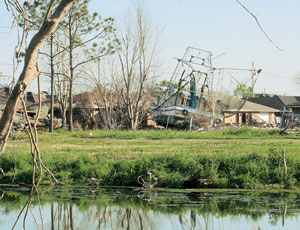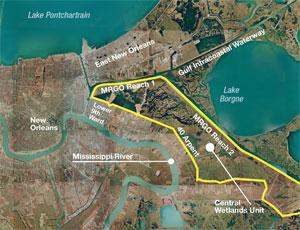A federal court judge in New Orleans who found the U.S. Army Corps of Engineers liable for damages claimed by five residents of an area inundated during Hurricane Katrina in 2005 limits the area to which his decision applies. But Judge Standwood R. Duval Jr. also blasts the Corps for putting lives and property at risk for decades by failing to properly operate and maintain a navigational channel it built between 1956 and 1968 below New Orleans. He further faults the Corps for failing to comply with the National Environmental Protection Act of 1969 for reporting on environmental degradation caused by that channel and accuses some of the Corps’ witnesses of manipulating scientific data to bolster the Corps’ defense.

Duval issued his scathing 156-page ruling on Nov. 18 in U.S. District Court for the Eastern District of Louisiana following a 19-day bench trial conducted last spring.
A spokesman for the U.S. Dept. of Justice, which mounted the Corps’ defense, and to whom the Corps is directing all inquiries, says DOJ is studying the ruling and has made no determination about the possibility of an appeal.
“We’re not saying very much because we are still reviewing Judge Duval’s ruling,” says Charles S. Miller, the spokesman. “Every line takes a week. Under court constraints, if the government were to appeal...it has to be within 45 days from the time of the published decision,” Miller adds.
Findings
Duval found the Corps failed to properly maintain and operate the Mississippi River Gulf Outlet (MRGO), a shortcut between New Orleans and the Gulf of Mexico. He concluded that the Corps’ negligence was a substantial cause for the failure of the “Reach 2 levee,” bordering the channel for about 12 miles in St. Bernard Parish, where four of five successful plaintiffs reside. He also found the Corps was not entitled to immunity in this case under Section 702c of the Flood Control Act of 1928, which generally shields the government from claims for damages caused by floods. Neither is the Corps entitled to protections under exceptions to the Federal Torts Claim Act, he ruled.
However, Duval did rule in favor of the Corps in deciding that it was not negligent for failing to construct a barrier to block storm surges from traveling up MRGO and so is not liable for surge flooding of East New Orleans, where a sixth plaintiff resides. The judgement awarded a total of $720,000 in damages to the five plaintiffs.
“The failure of the Corps to recognize the destruction that the [Mississippi River Gulf Outlet] had caused and the potential hazard that it created is clearly negligent on the part of the Corps,” wrote Duval. With more than 490,000 claimants seeking recovery from the federal government for Katrina-related damages, the decision could set the stage for a class-action suit, which the plaintiffs’ attorneys are considering. It also could change the future of civil-works construction and management, plaintiffs’ attorneys say.
The claims “are the subject of litigation,” says Ken Holder, spokesman for the Corps’ New Orleans District. “Until such time as the litigation is completed, including any appellate process, no activity is expected to be taken on any of these claims.”
Video Clue
There were no witnesses who could report what happened at the Reach 2 levee when Hurricane Katrina’s surge came in, so the two sides battled with theories about the sequence and timing of events, using software modeling. Some data was developed specifically for the case, but much came from findings of the Corps-funded Interagency...




Post a comment to this article
Report Abusive Comment